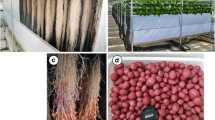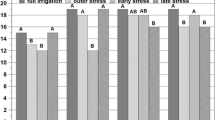Abstract
Potato (Solanum tuberosum L.) solids and reducing sugars were examined before, just after, and two weeks after transient water stress to gain an understanding of tuber changes that occur directly associated with water stress. Russet Burbank and A082260-8 potatoes were grown on Owyhee silt loam at the Malheur Experiment Station, Ontario, Oregon. Potatoes were subjected to a single episode of transient water stress by omitting furrow irrigation in either late June, July, or in early August of 1988 and 1989 to examine variety differences in the short term effects of water stress on changes in solids and reducing sugars in tuber stem ends. Irrigation was managed to maintain soil water potential above -65 kPa at 20 cm depth during tuber initiation through bulking except during transient stress when the soil water potential reached -82 to -110 kPa. Tuber samples were taken from plots and minimally stressed check treatments before stress, at the peak of stress, two weeks after the transient stress period, and after harvest. Tubers were sectioned longitudinally and the percent solids and reducing sugars were determined for samples from the tuber stem end, center, and apical end. Longitudinal tuber strips were fried after harvest to determine fry color. Tuber stem-end fry color did not darken in A082260-8 potatoes subjected to water stress. The line A082260-8 had higher stem-end solids and lower stem-end reducing sugars than Russet Burbank. Neither variety responded to transient water stress or recovery from transient stress with an immediate increase in reducing sugars in any tuber part. Reducing sugars were elevated in harvested tubers, particularly in the stem-ends of Russet Burbank potatoes subjected to water stress. Increases in tuber reducing sugars related to transient water stress were not found during the stress period or immediately after stress, but were present in harvested tubers.
Compendio
Se examinaron los sólidos y los azúcares reductores de la papa (Solanum tuberosum L.), antes, inmediatamente después y dos semanas después de un breve estrés al agua para determinar los cambios que ocurren en los tubérculos, directamente asociados con el estrés al agua. Papas Russet Burbank y A082260-8 se cultivaron en suelo franco-limoso de Owyhee en la Estación Experimental Malheur, Ontario, Oregón. Las papas fueron expuestas a un solo periodo de breve estrés al agua, omitiendo el riego por surco ya fuese al final de junio, julio o a comienzos de agosto de 1988 y 1989, para determinar las diferencias varietales en los efectos del corto periodo de estrés al agua sobre los sólidos y azúcares reductores en el extremo basal del tubérculo. La irrigación fué suministrada para mantener el potencial de agua del suelo por encima de -65 kPa a 20 cm de profundidad durante el inicio de la tuberización y durante todo el periodo de desarrollo de los tubérculos, excepto durante el breve estrés, en que el potencial de agua del suelo alcanzó de -82 a -100 kPa.
Se tomaron de las parcelas, y de los tratamientos testigo con estrés mínimo, muestras de tubérculos antes del estrés, al momento de máximo estrés, dos semanas después del breve periodo de estrés y después de la cosecha.
Los tubérculos fueron seccionados longitudinalmente y se determinó el porcentaje de sólidos y de azúcares reductores en muestras tomadas del extremo basal, centro y extremo apical de los mismos. Se frieron rebanadas longitudinales de papas después de la cosecha para determinar el color de la fritura. El color de las porciones basales, después de fritas, no se oscureció en las papas A082260-8 expuestas al estrés al agua. La línea A0822608 tuvo en el extremo basal más sólidos y menos azúcares reductores que Russet Burbank. Ninguna de las variedades respondió al breve estrés al agua o se recobraron del mismo con un aumento inmediato de azúcares reductores en alguna parte del tubérculo. Los azúcares reductores fueron abundantes en los tubérculos cosechados, particularmente en los extremos basales de las papas Russet Burbank expuestas al estrés al agua. Durante el periodo de estrés, o inmediatamente después, no se encontraron incrementos de azúcares reductores en los tubérculos en relation con el breve estrés al agua, pero sí se observaron en los tubérculos cosechados.
Similar content being viewed by others
Literature Cited
AOAC. 1984. “Official methods of analysis.” 14th ed. Assoc Off Anal Chem Inc. Arlington, Virginia.
Appleman, C.O. and E.V. Miller. 1926. A chemical and physiological study of maturity in potatoes. J Agric Res 33:569.
Blake, G.R., G.D. Brill and J.C. Campbell. 1955. Studies on supplemental irrigation of potatoes in New Jersey. Am Potato J 32:327.
Bodlaender, K.B.A., C. Lugt and J. Marinus. 1964. The induction of second-growth in potato tubers. Eur Potato J 7:57.
Bradley, G.A. 1955. Studies on the irrigation of potatoes, onions and beans. Diss Abstr No 6, Cornell University, Ithaca, N.Y.
Bradley, G.A. and A. J. Pratt. 1954. The response of potatoes to irrigation at different levels of available moisture. Am Potato J 31:305.
Bradley, G.A. and A.J. Pratt. 1955. The effect of different combinations of soil moisture and nitrogen levels on early plant development and tuber set of potato. Am Potato J 32:254.
Corey, G.L. and V.I. Myers. 1955. Irrigation of Russet Burbank potatoes in Idaho. Idaho Agric Expt Stat Bull 246, October.
Cykler, J.F. 1946. Effects of variations in available soil water on yield and quality of potatoes. Agric Eng 27:363.
Edmundson, W.C., L.A. Schaal and B.J. Landis, 1951. Potato growing in the Western states. USDA Farmers’ Bull No 2034.
Fuller, T.J. and J.C. Hughes. 1984. Factors influencing the relationships between reducing sugars and fry color of potato tubers of cv. Record J Food Technol 19:455.
Hiller, L.K., D.C. Koller and R.E. Thornton. 1985. Physiological disorders of potato tubers.In: Potato Physiology P.H. Li (Ed.). Academic Press. p.389.
Hodgson, W.A., D.D. Pond and J. Munro. 1973. Diseases and pests of potatoes. Can Dep Agric Publ 1492.
Iritani, W.M. 1981. Growth and preharvest stress and processing quality of potatoes. Am Potato J 58:71.
Iritani, W.M. and L. Weller. 1973. The development of translucent end tubers. Am Potato J 50:223.
Iritani, W.M. and L. Weller. 1973. Dry matter content of apical and basal portions of Russet Burbank potatoes. Am Potato J 50:389.
Iritani, W.M., L. Weller and T.S. Russel. 1973. Relative differences in sugar content of basal and apical portions of Russet Burbank Potatoes. Am Potato J 50:24.
Isherwood, F.A. 1973. Starch — sugar interconversion inSolanum tuberosum. Phytochem 12:2579.
Jensen, H.J. and Morris, O.M. 1931. Potato growing in the irrigated districts of Washington. Washington Agric Expt Stat Bull No 246.
Lugt, C. 1960. Second-growth phenomena. Eur Potato J 3:307.
Lugt, C., K.B.A. Bodlaender and G. Goodjik. 1964. Observations on the induction of second-growth in potato tubers. Eur Potato J 7:219.
Nielson, L.W. and W.C. Sparks. 1953. Bottleneck tubers and jelly-end rot in the Russet Burbank potato. Res Bull No 23 Univ of Idaho Agric Expt Stat.
Penman, F. 1929. Glassy end of potatoes. Jour Dept of Agric Victoria 27:449.
Prince, A.B. and P.T. Blood. 1962. Some effects of irrigation and fertilization on the yield and quality of Kennebec potatoes. Am Potato J 39:313.
Rees, T.A. and S. Morrell. 1990. Carbohydrate metabolism in developing potatoes. Am Potato J 67:835.
Robins, J.S. and C.E. Domingo. 1956. Potato yield and tuber shape as affected by severe soil-moisture deficits and plant spacing. Agronomy J 48:488.
Ross, A.F. 1959. Dinitrophenol method for reducing sugars.In: Potato processing. Talburt, W.F. and Ora Smith (Ed.). Avi Publishing Co., Westport, Conn. p. 588.
Snyder, J., S. Desborough and D. Holm. 1977. Accumulation of protein, non-protein nitrogen and starch during tuber growth of three potato cultivars. Am Potato J 54:545.
Struchtemeyer, R.A. 1954. The effect of supplementary water and fertilizer on the composition and yield of potatoes in central Maine. Abstract Doctoral Diss No 65. The Ohio State Uni Press.
Taylor, S.T. 1952. Use of mean soil moisture tension to evaluate the effects of soil moisture on crop yields. Soil Sci 74:217.
USDA. 1972. Color standards for frozen French fried potatoes. Third ed. Munsell Color Company, Baltimore, Maryland. 64–1.
van Heemst, H.D.J. 1986. The distribution of dry matter during growth of a potato crop. Potato Res 29:55.
van Loon, C.D. 1981. The effect of water stress on potato growth, development, and yield. Am Potato J 58:51.
Weaver, M.L., H. Timm, M. Nonaka, R.N. Sanyre, R.M. McCrendy and I.C. Whitehand. 1978a. Potato composition: I. Tissue selection and its effects on solids content and amylose/amylopectin ratios. Am Potato J 55:73.
Weaver, M.L., H. Timm, M. Nonaka, R.N. Sanyre, R.M. McCrendy and I.C. Whitehand. 1978b. Potato composition: II. Tissue selection and its effects on total sugar, total reducing sugar, glucose fructose and sucrose contents. Am Potato J 55:83.
Werner, H.O. 1947. Commercial potato production in Nebraska. Nebraska Agric Expt Stat Bull No 384.
Yamaguchi, M., J.W. Perdue and J.H. MacGillivray. 1960. Nutrient composition of white Rose potatoes during growth and after storage. Am Potato J 37:73.
Author information
Authors and Affiliations
Additional information
Oregon State University Agricultural Experiment Station Technical Paper Number 9849.
Rights and permissions
About this article
Cite this article
Shock, C.C., Holmes, Z.A., Stieber, T.D. et al. The effect of timed water stress on quality, total solids and reducing sugar content of potatoes. American Potato Journal 70, 227–241 (1993). https://doi.org/10.1007/BF02849311
Accepted:
Issue Date:
DOI: https://doi.org/10.1007/BF02849311




